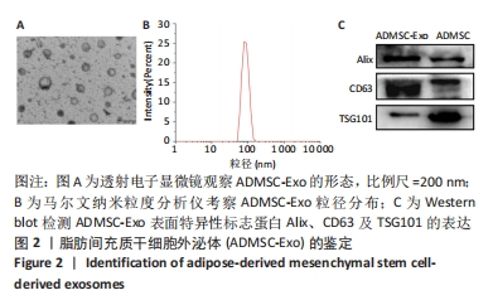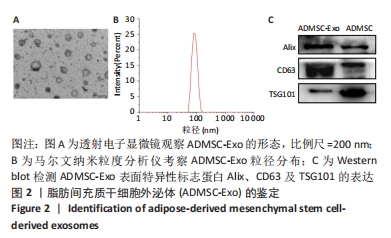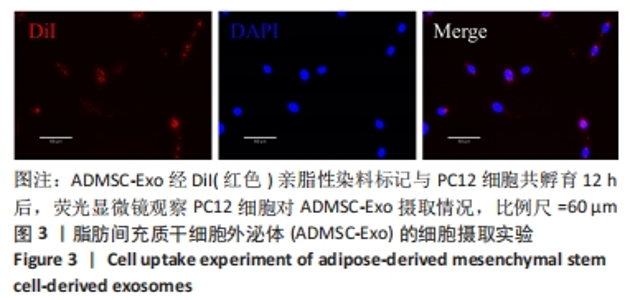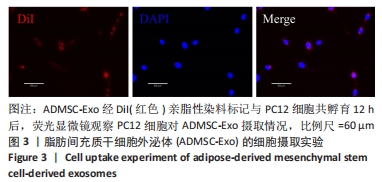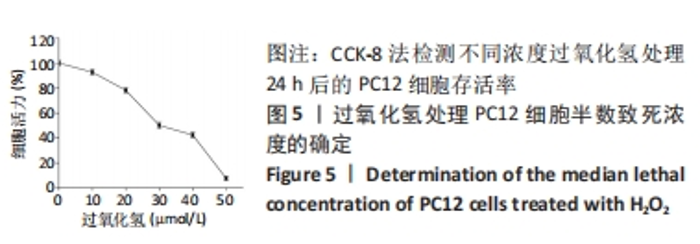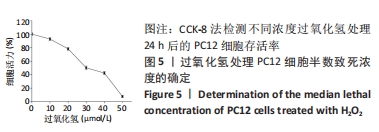Chinese Journal of Tissue Engineering Research ›› 2024, Vol. 28 ›› Issue (19): 2988-2995.doi: 10.12307/2024.165
Previous Articles Next Articles
Adipose-derived mesenchymal stem cell-derived exosomes alleviate hydrogen peroxide-induced PC12 cell apoptosis
Gu Chengxu1, Zhang Naili1, Meng Yongchun2, Liu Qing3, Guo Qixuan1, Fu Li1, Zhang Luping1, Huang Fei1, 4
- 1Department of Human Anatomy, School of Basic Medical Science, Binzhou Medical University, Yantai 264003, Shandong Province, China; 2Yantai Affiliated Hospital of Binzhou Medical University, Yantai 264100, Shandong Province, China; 3Department of Human Anatomy, School of Basic Medicine, Cheeloo College of Medicine, Shandong University, Jinan 250021, Shandong Province, China; 4School of Health and Life Sciences, University of Health and Rehabilitation Sciences, Qingdao 266071, Shandong Province, China
-
Received:2023-05-13Accepted:2023-06-16Online:2024-07-08Published:2023-09-26 -
Contact:Huang Fei, PhD, Professor, Department of Human Anatomy, School of Basic Medical Science, Binzhou Medical University, Yantai 264003, Shandong Province, China; School of Health and Life Sciences, University of Health and Rehabilitation Sciences, Qingdao 266071, Shandong Province, China -
About author:Gu Chengxu, Master candidate, Department of Human Anatomy, School of Basic Medical Science, Binzhou Medical University, Yantai 264003, Shandong Province, China -
Supported by:National Natural Science Foundation of China, Nos. 81870985 and 82271432 (to HF)
CLC Number:
Cite this article
Gu Chengxu, Zhang Naili, Meng Yongchun, Liu Qing, Guo Qixuan, Fu Li, Zhang Luping, Huang Fei. Adipose-derived mesenchymal stem cell-derived exosomes alleviate hydrogen peroxide-induced PC12 cell apoptosis[J]. Chinese Journal of Tissue Engineering Research, 2024, 28(19): 2988-2995.
share this article
Add to citation manager EndNote|Reference Manager|ProCite|BibTeX|RefWorks
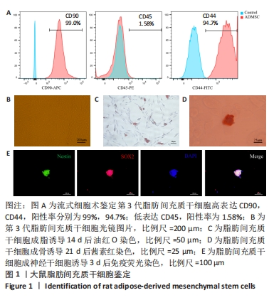
2.1 脂肪间充质干细胞的鉴定结果 见图1。从大鼠腹股沟区皮下或附睾周围的脂肪组织中提取脂肪间充质干细胞,培养传代后,光学显微镜观察显示第3代脂肪间充质干细胞形态均一,呈典型的鱼群样、成纤维状、漩涡式排列生长,无明显蝉翼样变宽分化现象。流式细胞仪鉴定第3代脂肪间充质干细胞的表面抗原,结果显示高表达CD90,CD44,阳性率分别为99%,94.7%;低表达CD45,阳性率为1.58%。经成脂诱导14 d后,可见细胞形态逐渐由长梭形变为多边形或圆形,胞浆内积聚了大小不等的脂肪滴,经油红O染色后脂肪滴呈鲜艳深红色。经成骨诱导21 d后,可见细胞逐渐由长梭形变为多边形,呈聚集样、铺路石样多层生长,表面有大小不等的黑色小颗粒,局部有矿化样的结晶物,经茜素红染色后可见“蘑菇样”散落分布、大小不等的深红色球形结节。经成神经干诱导分化3 d后,经神经干细胞表面标记蛋白Nestin及SOX2荧光染色后鉴定具有神经干细胞特性。以上结果说明已成功分离出大鼠脂肪间充质干细胞。"
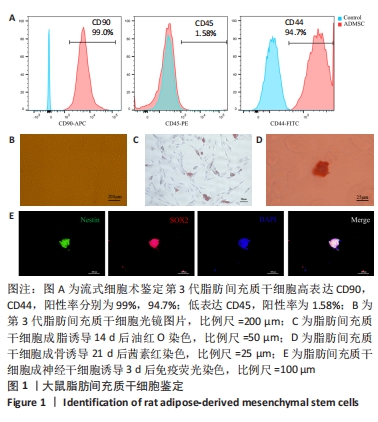
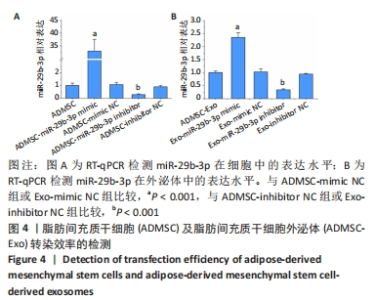
2.4 脂肪间充质干细胞及ADMSC-Exo转染效率 首先向脂肪间充质干细胞转染miR-29b-3p mimic及miR-29b-3p inhibitor,RT-qPCR检测转染后脂肪间充质干细胞中miR-29b-3p的转染效率,统计结果显示miR-29b-3p mimic转染的脂肪间充质干细胞中miR-29b-3p的表达显著上调,而miR-29b-3p inhibitor转染的脂肪间充质干细胞中miR-29b-3p的表达显著下调,见图4A;随后从细胞培养上清中提取外泌体,RT-qPCR检测外泌体中miR-29b-3p的表达水平,结果显示转染miR-29b-3p mimic的ADMSC-Exo中miR-29b-3p的表达上调,而转染miR-29b-3p inhibitor的ADMSC-Exo中miR-29b-3p的表达下调,见图4B。"
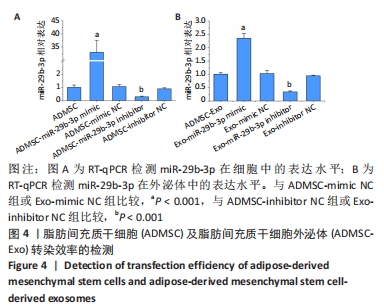
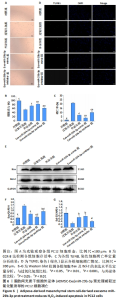
2.6 ADMSC-Exo miR-29b-3p预处理减轻过氧化氢诱导的PC12细胞凋亡 与对照组相比,30 μmol/L过氧化氢处理PC12细胞24 h后,细胞突起严重受损,细胞存活率显著降低;与过氧化氢组相比,ADMSC-Exo预处理后PC12细胞突起受损程度减轻,且存活率高于过氧化氢组;过表达miR-29b-3p的ADMSC-Exo 预处理后可进一步增强外泌体的保护作用;反之,抑制miR-29b-3p的表达则减弱了外泌体的神经保护作用,见图6A,B。TUNEL染色结果显示,与过氧化氢组相比,ADMSC-Exo预处理后PC12细胞的凋亡率明显下降;过表达miR-29b-3p的ADMSC-Exo预处理后细胞的凋亡率低于ADMSC-Exo预处理的PC12细胞,敲低miR-29b-3p的ADMSC-Exo预处理后细胞的凋亡率明显高于ADMSC-Exo预处理的PC12细胞,见图6C,D。Western blot进一步证实,过表达miR-29b-3p的ADMSC-Exo预处理可上调PC12细胞中抗凋亡蛋白Bcl-2的表达,下调凋亡蛋白Bax的表达;相反,敲低miR-29b-3p表达的ADMSC-Exo预处理可下调PC12细胞中Bcl-2的表达,而上调Bax的表达,见图6E-G。"
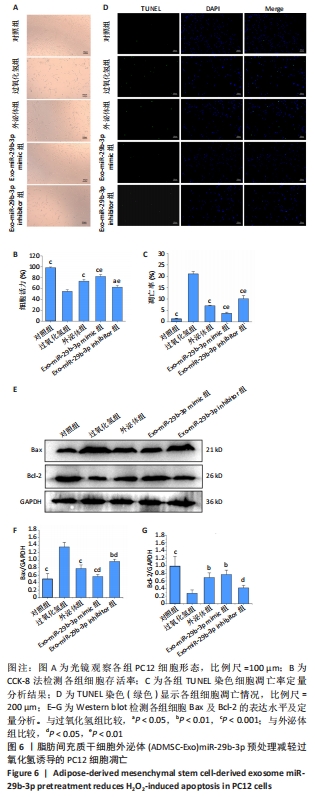
| [1] LI J, JING Y, BAI F, et al. Induced pluripotent stem cells as natural biofactories for exosome carrying miR-199b-5p in the treatment of spinal cord injury. Front Pharmacol. 2023;13:1078761. [2] LIU X, ZHANG L, XU Z, et al. A functionalized collagen-I scaffold delivers microRNA 21-loaded exosome for spinal cord injury repair. Acta Biomater. 2022;154:385-400. [3] SHI LB, TANG PF, ZHANG W, et al. Naringenin inhibits spinal cord injury-induced activation of neutrophils through miR-223. Gene. 2016; 592(1):128-133. [4] AHUJA CS, NORI S, TETREAULT L, et al. Traumatic Spinal Cord Injury-Repair and Regeneration. Neurosurgery. 2017;80(3S):S9-S22. [5] RAMALHO BDS, DE ALMEIDA FM, MARTINEZ AMB. Cell therapy and delivery strategies for spinal cord injury. Histol Histopathol. 2021;36(9): 907-920. [6] AZARI MF, MATHIAS L, OZTURK E, et al. Mesenchymal stem cells for treatment of CNS injury. Curr Neuropharmacol. 2010;8(4):316-323. [7] LI X, GUAN Y, LI C, et al. Immunomodulatory effects of mesenchymal stem cells in peripheral nerve injury. Stem Cell Res Ther. 2022;13(1): 18. [8] BASILE M, MARCHEGIANI F, NOVAK S, et al. Human amniotic fluid stem cells attract osteoprogenitor cells in bone healing. J Cell Physiol. 2020; 235(5):4643-4654. [9] ZENG CW. Multipotent Mesenchymal Stem Cell-Based Therapies for Spinal Cord Injury: Current Progress and Future Prospects. Biology (Basel). 2023;12(5):653. [10] REN K. exosome in perspective: a potential surrogate for stem cell therapy. Odontology. 2019;107(3):271-284. [11] PROPERZI F, FERRONI E, POLEGGI A, et al. The regulation of exosome function in the CNS: implications for neurodegeneration. Swiss Med Wkly. 2015;145:w14204. [12] SPEES JL, LEE RH, GREGORY CA. Mechanisms of mesenchymal stem/stromal cell function. Stem Cell Res Ther. 2016;7(1):125. [13] HUANG JH, YIN XM, XU Y, et al. Systemic Administration of exosome Released from Mesenchymal Stromal Cells Attenuates Apoptosis, Inflammation, and Promotes Angiogenesis after Spinal Cord Injury in Rats. J Neurotrauma. 2017;34(24):3388-3396. [14] LOU G, CHEN Z, ZHENG M, et al. Mesenchymal stem cell-derived exosome as a new therapeutic strategy for liver diseases. Exp Mol Med. 2017;49(6):e346. [15] WANG X, BOTCHWAY BOA, ZHANG Y, et al. Combinational Treatment of Bioscaffolds and Extracellular Vesicles in Spinal Cord Injury. Front Mol Neurosci. 2019;12:81. [16] LIANG Y, WU JH, ZHU JH, et al. Exosome Secreted by Hypoxia-Pre-conditioned Adipose-Derived Mesenchymal Stem Cells Reduce Neuronal Apoptosis in Rats with Spinal Cord Injury. J Neurotrauma. 2022;39(9-10):701-714. [17] WANG L, PEI S, HAN L, et al. Mesenchymal Stem Cell-Derived exosome Reduce A1 Astrocytes via Downregulation of Phosphorylated NFκB P65 Subunit in Spinal Cord Injury. Cell Physiol Biochem. 2018;50(4): 1535-1559. [18] NIKFARJAM S, REZAIE J, ZOLBANIN NM, et al. Mesenchymal stem cell derived-exosome: a modern approach in translational medicine. J Transl Med. 2020;18(1):449. [19] HOU K, LI G, ZHAO J, et al. Bone mesenchymal stem cell-derived exosomal microRNA-29b-3p prevents hypoxic-ischemic injury in rat brain by activating the PTEN-mediated Akt signaling pathway. J Neuroinflammation. 2020;17(1):46. [20] DAI Y, MAO Z, HAN X, et al. MicroRNA-29b-3p reduces intestinal ischaemia/reperfusion injury via targeting of TNF receptor-associated factor 3. Br J Pharmacol. 2019;176(17):3264-3278. [21] WIDLANSKY ME, JENSEN DM, WANG J, et al. miR-29 contributes to normal endothelial function and can restore it in cardiometabolic disorders. EMBO Mol Med. 2018;10(3):e8046. [22] TAO R, FAN XX, YU HJ, et al. MicroRNA-29b-3p prevents Schistosoma japonicum-induced liver fibrosis by targeting COL1A1 and COL3A1. J Cell Biochem. 2018;119(4):3199-3209. [23] LIANG JN, ZOU X, FANG XH, et al. The Smad3-miR-29b/miR-29c axis mediates the protective effect of macrophage migration inhibitory factor against cardiac fibrosis. Biochim Biophys Acta Mol Basis Dis. 2019;1865(9):2441-2450. [24] MA K, XU H, ZHANG J, et al. Insulin-like growth factor-1 enhances neuroprotective effects of neural stem cell exosome after spinal cord injury via an miR-219a-2-3p/YY1 mechanism. Aging (Albany NY). 2019; 11(24):12278-12294. [25] ZHAI L, SHEN H, SHENG Y, et al. ADMSC Exo-MicroRNA-22 improve neurological function and neuroinflammation in mice with Alzheimer’s disease. J Cell Mol Med. 2021;25(15):7513-7523. [26] GUO X, KANG J, WANG Z, et al. Nrf2 Signaling in the Oxidative Stress Response After Spinal Cord Injury. Neuroscience. 2022; 498: 311-324. [27] VISMARA I, PAPA S, ROSSI F, et al. Current Options for Cell Therapy in Spinal Cord Injury. Trends Mol Med. 2017;23(9):831-849. [28] DASARI, RAMESH V. Mesenchymal stem cells in the treatment of spinal cord injuries: A review. World Journal of Stem Cells. 2014;6(2):120-133. [29] GIMONA M, PACHLER K, LANER-PLAMBERGER S, et al. Manufacturing of Human Extracellular Vesicle-Based Therapeutics for Clinical Use. Int J Mol Sci. 2017;18(6):1190. [30] SUNG SE, SEO MS, KIM YI, et al. Human Epidural AD-MSC exosome Improve Function Recovery after Spinal Cord Injury in Rats. Biomedicines. 2022;10(3):678. [31] SCHREML S, BABILAS P, FRUTH S, et al. Harvesting human adipose tissue-derived adult stem cells: resection versus liposuction. Cytotherapy. 2009;11(7) 947-957. [32] LIU AM, CHEN BL, YU LT, et al. Human adipose tissue- and umbilical cord-derived stem cells: which is a better alternative to treat spinal cord injury? Neural Regen Res. 2020;15(12):2306-2317. [33] CAMUSSI G, DEREGIBUS MC, BRUNO S, et al. Exosome/microvesicle-mediated epigenetic reprogramming of cells. Am J Cancer Res. 2011; 1(1):98-110. [34] WONG DE, BANYARD DA, SANTOS PJF, et al. Adipose-derivedstem cell extracellular vesicles: A systematic review. J Plast Reconstr Aesthet Surg. 2019;72(7):1207-1218. [35] FANG Y, ZHANG Y, ZHOU J, et al. Adipose-derived mesenchymal stem cell exosomes: a novel pathway for tissues repair. Cell Tissue Bank. 2019;20(2):153-161. [36] HUANG JH, FU CH, XU Y, et al. Extracellular Vesicles Derived from Epidural Fat-Mesenchymal Stem Cells Attenuate NLRP3 Inflammasome Activation and Improve Functional Recovery After Spinal Cord Injury. Neurochem Res. 2020;45(4):760-771. [37] BRITES D, FERNANDES A. Neuroinflammation and Depression: Microglia Activation, Extracellular Microvesicles and microRNA Dysregulation. Front Cell Neurosci. 2015;9:476. [38] LI C, LI X, ZHAO B, et al. exosome derived from miR-544-modified mesenchymal stem cells promote recovery after spinal cord injury. Arch Physiol Biochem. 2020;126(4):369-375. [39] CHANG Q, HAO Y, WANG Y, et al. Bone marrow mesenchymal stem cell-derived exosomal microRNA-125a promotes M2 macrophage polarization in spinal cord injury by downregulating IRF5. Brain Res Bull. 2021;170:199-210. [40] GUO ZY, SUN X, XU XL, et al. Human umbilical cord mesenchymal stem cells promote peripheral nerve repair via paracrine mechanisms. Neural Regen Res. 2015;10(4):651-658. [41] BONAFEDE R, SCAMBI I, PERONI D, et al. Exosome derived from murine adipose-derived stromal cells: Neuroprotective effect on in vitro model of amyotrophic lateral sclerosis. Exp Cell Res. 2016;340(1):150-158. [42] LU J, ASHWELL KW, WAITE P. Advances in secondary spinal cord injury: role of apoptosis. Spine (Phila Pa 1976). 2000;25(14):1859-1866. |
| [1] | Yang Yifeng, Ye Nan, Wang Lin, Guo Shuaicheng, Huang Jian. Signaling pathway of dexmedetomidine against ischemia-reperfusion injury [J]. Chinese Journal of Tissue Engineering Research, 2024, 28(9): 1464-1469. |
| [2] | Yue Yun, Wang Peipei, Yuan Zhaohe, He Shengcun, Jia Xusheng, Liu Qian, Li Zhantao, Fu Huiling, Song Fei, Jia Menghui. Effects of croton cream on JNK/p38 MAPK signaling pathway and neuronal apoptosis in cerebral ischemia-reperfusion injury rats [J]. Chinese Journal of Tissue Engineering Research, 2024, 28(8): 1186-1192. |
| [3] | Liu Hanfeng, Wang Jingjing, Yu Yunsheng. Artificial exosomes in treatment of myocardial infarction: current status and prospects [J]. Chinese Journal of Tissue Engineering Research, 2024, 28(7): 1118-1123. |
| [4] | Liu Tao, He Zhijun, Li Jinpeng, Song Yuan, Yao Xingzhang, Chen Wen, Li Yan, Bai Bihui. Role and mechanism of noncoding RNA in diabetic peripheral neuropathy [J]. Chinese Journal of Tissue Engineering Research, 2024, 28(7): 1124-1129. |
| [5] | Ma Shuwei, He Sheng, Han Bing, Zhang Liaoyun. Exosomes derived from mesenchymal stem cells in treatment of animals with acute liver failure: a meta-analysis [J]. Chinese Journal of Tissue Engineering Research, 2024, 28(7): 1137-1142. |
| [6] | Liu Jianhong, Liao Shijie, Li Boxiang, Tang Shengping, Wei Zhendi, Ding Xiaofei. Extracellular vesicles carrying non-coding RNA regulate the activation of osteoclasts [J]. Chinese Journal of Tissue Engineering Research, 2024, 28(7): 1076-1082. |
| [7] | Shen Ziqing, Xia Tian, Shan Yibo, Zhu Ruijun, Wan Haoxin, Ding Hao, Pan Shu, Zhao Jun. Vascularized tracheal substitutes constructed by exosome-load hydrogel-modified 3D printed scaffolds [J]. Chinese Journal of Tissue Engineering Research, 2024, 28(5): 697-705. |
| [8] | Shen Feiyan, Yao Jixiang, Su Shanshan, Zhao Zhongmin, Tang Weidong. Knockdown of circRNA WD repeat containing protein 1 inhibits proliferation and induces apoptosis of chondrocytes in knee osteoarthritis [J]. Chinese Journal of Tissue Engineering Research, 2024, 28(4): 499-504. |
| [9] | Chen Zepeng, Hou Yonghui, Chen Shudong, Hou Yu, Lin Dingkun. Tauroursodeoxycholic acid treats spinal cord injury by reducing apoptosis of spinal cord neurons under glucose and oxygen deprivation [J]. Chinese Journal of Tissue Engineering Research, 2024, 28(4): 528-534. |
| [10] | Dai Jing, Liu Shasha, Shen Mingjing. Exosome-loaded injectable hydrogel for repairing bone defects around implants [J]. Chinese Journal of Tissue Engineering Research, 2024, 28(3): 347-354. |
| [11] | Xie Ting, Liu Tingting, Zeng Xuehui, Li Yamin, Zhou Panghu, Yi Nianhua. Fucoxanthin alleviates glucocorticoid-induced osteoblast apoptosis by activating nuclear factor erythroid-2-related factor 2 [J]. Chinese Journal of Tissue Engineering Research, 2024, 28(23): 3609-3614. |
| [12] | Ma Wanli, Yang Hongsheng, Qu Bo, Zhang Zhengdong, Gong Kai, Lin Yanshui. Mechanisms by which baicalein protects against steriod-induced osteonecrosis of the femoral head in rats [J]. Chinese Journal of Tissue Engineering Research, 2024, 28(23): 3661-3668. |
| [13] | Zhu Yongzhao, Fang Chao, Zhao Fang, Zhang Qing, Zhao Dan. Mechanism by which lycium barbarum polysaccharides inhibit keratinocyte apoptosis in burn wounds via autophagy [J]. Chinese Journal of Tissue Engineering Research, 2024, 28(23): 3686-3691. |
| [14] | Ning Taoli, Xie Yan, Wang Na, Wang Qingfeng, Ji Jian, Zhang Dongna. Grape seed extract inhibits apoptosis in growth plate chondrocytes and promotes tibial growth in rats [J]. Chinese Journal of Tissue Engineering Research, 2024, 28(20): 3216-3222. |
| [15] | Zhou Shuliang, Xu Liang, Qian Xuefeng, Zeng Jincai, Zhu Lifan. Correlation between the expression of miRNA-142-3p, mixed lineage kinase 3 and interleukin-1beta in nucleus pulposus and the degree of lumbar intervertebral disc degeneration [J]. Chinese Journal of Tissue Engineering Research, 2024, 28(2): 165-171. |
| Viewed | ||||||
|
Full text |
|
|||||
|
Abstract |
|
|||||
